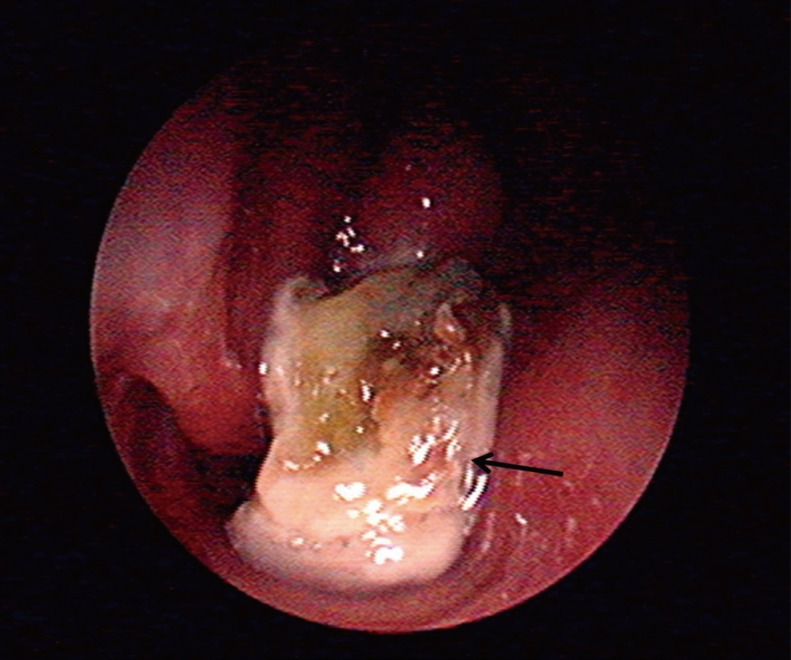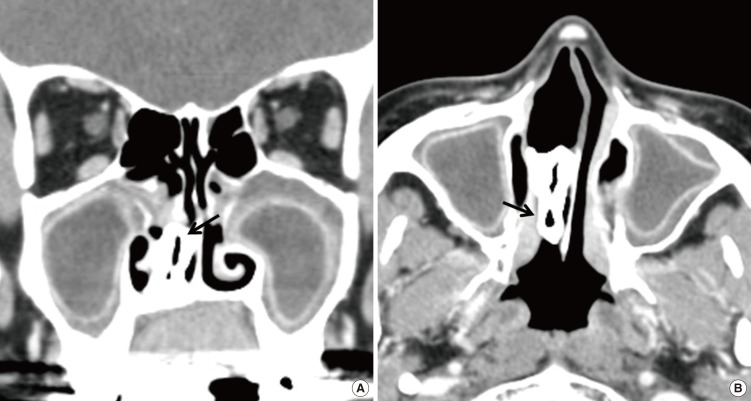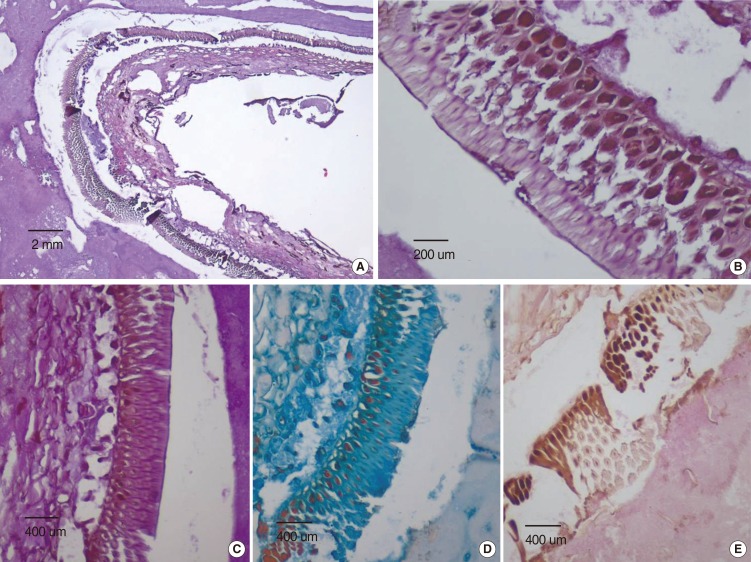Clin Exp Otorhinolaryngol.
2014 Dec;7(4):334-337. 10.3342/ceo.2014.7.4.334.
Vegetable or Pulse Granuloma in the Nasal Cavity
- Affiliations
-
- 1Department of Otolaryngology, Gangneung Asan Hospital, University of Ulsan College of Medicine, Gangneung, Korea. newnew1@hanmail.net
- 2Department of Pathology, Gangneung Asan Hospital, University of Ulsan College of Medicine, Gangneung, Korea.
- KMID: 2278377
- DOI: http://doi.org/10.3342/ceo.2014.7.4.334
Abstract
- Vegetable granuloma or pulse granuloma results from the implantation of food particles of vegetable origin. Pulse granulomas have mainly been reported in association with lung aspirations, the oral cavity with a history of oral procedures and less frequently in gastrointestinal tracks. We report a 31-year-old woman who presented with right nasal obstruction and was found to have a firm mass in the right nasal cavity. Paranasal sinus computerized tomography scans identified a calcified ring lesion in her right nasal cavity. Endoscopic sinus surgery was performed, and pathology examination revealed a lesion consistent with a pulse granuloma that contains starch granules with cellulose envelopes appearing as hyaline rings surrounded by inflammation cells and concentrically arranged delicate connective tissue. Pulse granuloma is a well described entity with distinct histopathology. However, pulse granulomas are rare, and especially extraoral pulse granulomas are extremely rare. We found that pulse granuloma can be occurred in the nasal cavity through regurgitation.
Keyword
MeSH Terms
Figure
Reference
-
1. Talacko AA, Radden BG. Oral pulse granuloma: clinical and histopathological features. A review of 62 cases. Int J Oral Maxillofac Surg. 1988; 12. 17(6):343–346. PMID: 2464044.
Article2. Nambudripad R, Narula N, Wu ML. Iatrogenic pulse granuloma detected at prostatectomy. Int J Surg Pathol. 2008; 1. 16(1):96–100. PMID: 18203796.
Article3. Philipsen HP, Reichart PA. Pulse or hyaline ring granuloma: review of the literature on etiopathogenesis of oral and extraoral lesions. Clin Oral Investig. 2010; 4. 14(2):121–128.
Article4. Karamurzin YS, Narula S, Khanifar E, Kim YS, Wu ML. Pulse granulomas in highly unusual sites. Histopathology. 2009; 1. 54(2):268–269. PMID: 19207957.
Article5. Harrison JD, Martin IC. Oral vegetable granuloma: ultrastructural and histological study. J Oral Pathol. 1986; 7. 15(6):322–326. PMID: 2428961.
Article6. Dunlap CL, Barker BF. Giant-cell hyalin angiopathy. Oral Surg Oral Med Oral Pathol. 1977; 10. 44(4):587–591. PMID: 71674.
Article7. Hase MP, Radden BG, Reade PC. Torulopsis glabrata infection in the oral cavity. J Oral Pathol. 1976; 1. 5(1):8–16. PMID: 814222.
Article8. Zhai J, Maluf HM. Peridiverticular colonic hyaline rings (pulse granulomas): report of two cases associated with perforated diverticula. Ann Diagn Pathol. 2004; 12. 8(6):375–379. PMID: 15614745.
Article
- Full Text Links
- Actions
-
Cited
- CITED
-
- Close
- Share
- Similar articles
-
- A Case of Giant Nasal Lobular Capillary Hemangioma During Pregnancy
- Two Cases of Midline Granuloma of the Face
- Analysis of the Results Endonasal Dacryocystorhinostomy Related to Nasal Cavity State
- CT Evaluation of Nasal Cavity Masses: Differential Diagnosis between Nasal Polyps and Their Mimics
- A Case of 2-Month-Old Infant with Lobular Capillary Hemangioma




